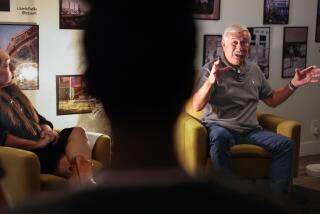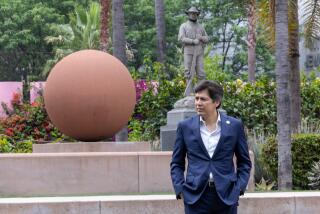A Nagging Debate : Family Wants Horse Owners to Drop Camarillo Name
- Share via
CAMARILLO — At the funeral Mass for Carmen Camarillo Jones six years ago, a white stallion with an empty saddle stood sentry at the entrance to the church.
To the members of the family that had founded the city of Camarillo, the occasion was assumed to be the end of public appearances for the celebrated matched team known as the Camarillo White Horses.
A few months later, Jones’ 11 white horses were sold at auction. Camarillo family members thought that was the last time they would see the horses together.
But the Camarillo White Horses reappeared on the parade circuit in 1988, one year after the auction. They have since been featured regularly in the Camarillo Christmas Parade, the Tournament of Roses and other events.
The new team features eight horses. At first, one mare in the group belonged to a great-nephew of Jones. But since 1990, none of the horses being presented as Camarillo White Horses has been owned by a member of the Camarillo family.
Some family members say that the horse owners are violating the last wishes of Carmen Camarillo Jones.
“Her intent was that the tradition of the Camarillo family white horses parading would come to an end,” said Paquita Parker, 62, an Ojai resident and niece of the matriarch.
Gerald Fitzgerald, a nephew of Jones and executor of her estate, said his aunt directed in her will that the horses be sold. He said it was a tacit understanding that their parade appearances would end.
“I think she would have been alarmed and had a fit if she knew other people were going to be taking it over,” he said. “My aunt was a very proud woman.”
Fitzgerald and some other family members say they would not mind so much if the new owners would use another name.
“Leave the Camarillo name out of it,” Fitzgerald said. “It’s our family name.”
But to the new owners, there is no other name for the elegant horses.
“They are the Camarillo horses,” said Ojai resident Priscilla Stuart-Galgas, who owns two of the animals. “How can I call them something they aren’t?”
Stuart-Galgas organized the new parade unit after contacting six other owners, including some whose animals were never owned by Jones but are offspring of her stock.
The other owners are Ojai residents Tanya Langkopf and Nadine Webb and Camarillo residents Judy Aronson, Audra Seldeen, and Martin and Jane Gish.
Stuart-Galgas said the Camarillo family lost exclusive rights to its ancestral name when its patriarch, Adolfo Camarillo--Carmen’s father--founded a town on his 10,000-acre ranch.
“Maybe Camarillo city bank or Camarillo plumbing or Camarillo used-car lot is taking their name, too,” she said.
Although the white horses bred by the Camarillo family are about seven-eighths quarter horse and not a registered breed, they are distinct enough to keep their traditional name, Stuart-Galgas said.
The horses have pink skin and dark eyes, which distinguishes them from albino horses and white Arabians, Parker said.
Albino horses, which are white because they lack pigment, have pink skin and light eyes, while white Arabians have grayish skin and dark eyes, Parker said.
Adolfo Camarillo started his line of horses with a stallion named Sultan that he purchased at the 1921 California State Fair in Sacramento.
He began showing the horses in the 1930s, with his daughter Carmen continuing the tradition after his death in 1958.
Ridden by family members and friends wearing traditional Mexican costumes, the horses were exhibited in parades around the state, from the San Francisco California Centennial Parade in 1950 to the Hollywood Christmas Parade and Santa Barbara Fiesta Days.
The white horses began as a Camarillo family custom, but they evolved into a part of history, said Stuart-Galgas and other owners.
Indeed, an image of Adolfo Camarillo on a white stallion is the official Camarillo city logo, appearing on street signs, city-owned vehicles and in City Hall.
“How are we supposed to obliterate history?” said Seldeen, 47, one of the horse owners.
“These horses were bred to be paraded,” said Langkopf, another owner. “The city of Camarillo greets us with the biggest smile” in the annual Christmas parade. “They love us.”
Langkopf and the other owners said they don’t benefit financially from exhibiting the animals.
“We do it for sheer pleasure, joy and love of these horses,” she said. “We all feel the horses should be together.”
At least one member of the Camarillo family agrees. Steve Petit, a great-grandson of Adolfo, purchased one horse at the auction but later gave the mare to Langkopf.
Petit said he intended the horse as a gift for his daughter as a way to preserve a piece of family history. But after Stuart-Galgas contacted him, he exhibited the animal with the group for two years.
He gave the mare to Langkopf in 1990, when it became apparent that his daughter preferred MTV to horseback riding, he said.
Petit, who lives in San Juan Capistrano, said his relatives should not be sanctimonious about having their name used: “We’re not the Pope or something.”
He said Stuart-Galgas’ group filled a void created by Jones’ death because no Camarillo family member stepped forward to take responsibility for keeping and showing the horses.
But Fitzgerald said his Aunt Carmen preferred to see the parading tradition end rather than to bequeath the horses to a family member who may not be willing or able to care for them properly.
“We’re not going to quit riding the horses, and most likely we’re not going to quit calling them the Camarillo White Horses,” said Seldeen. “This will go on forever.”






